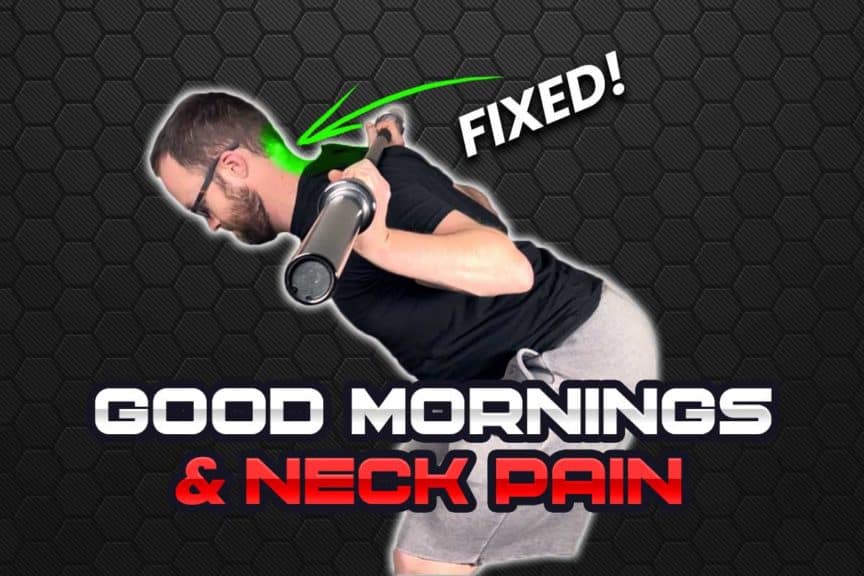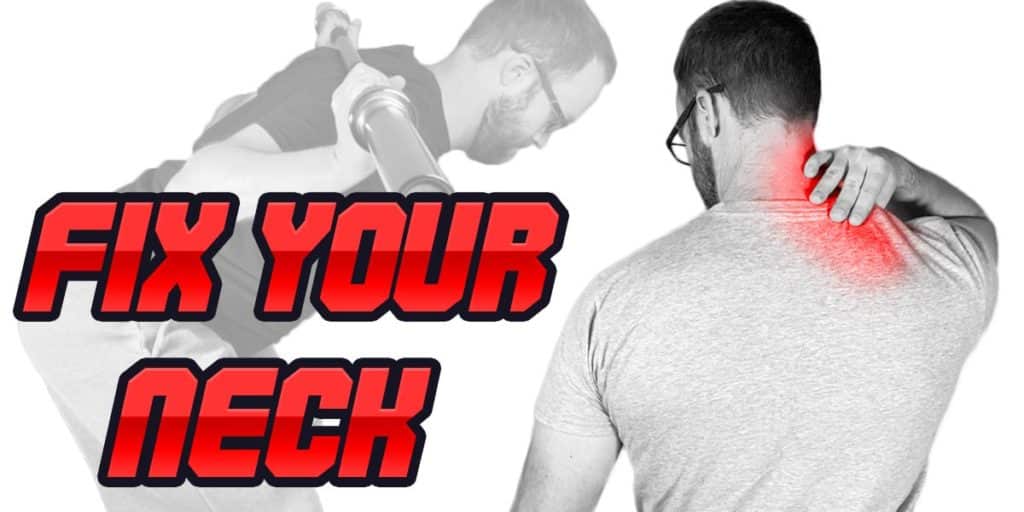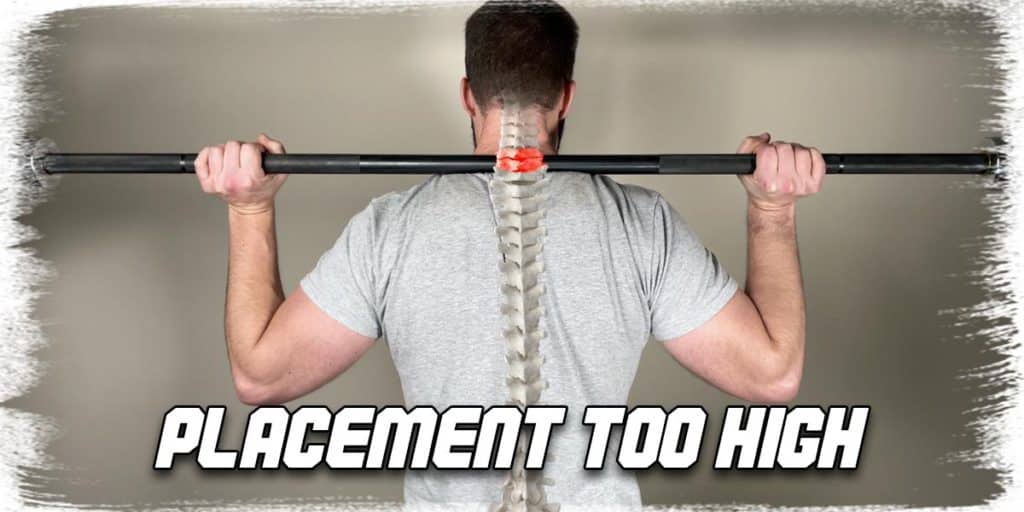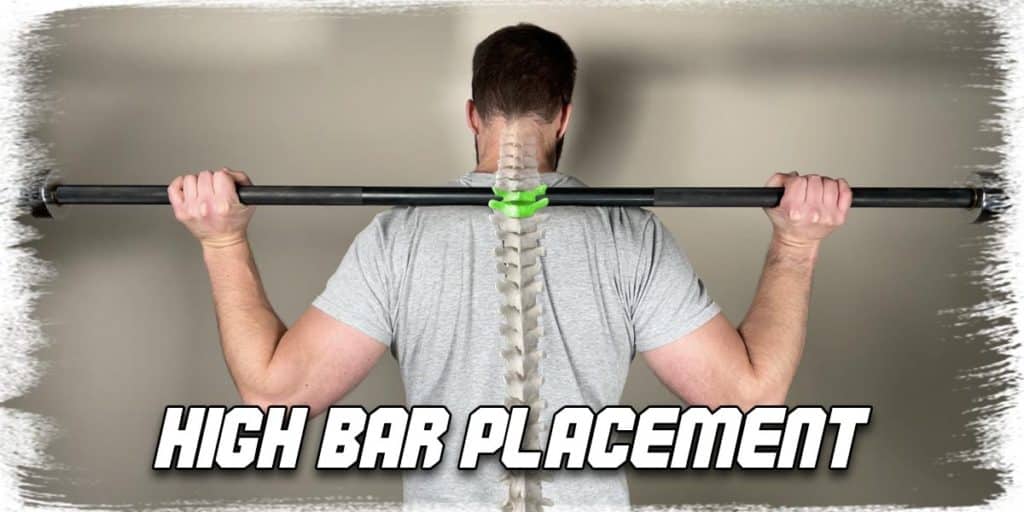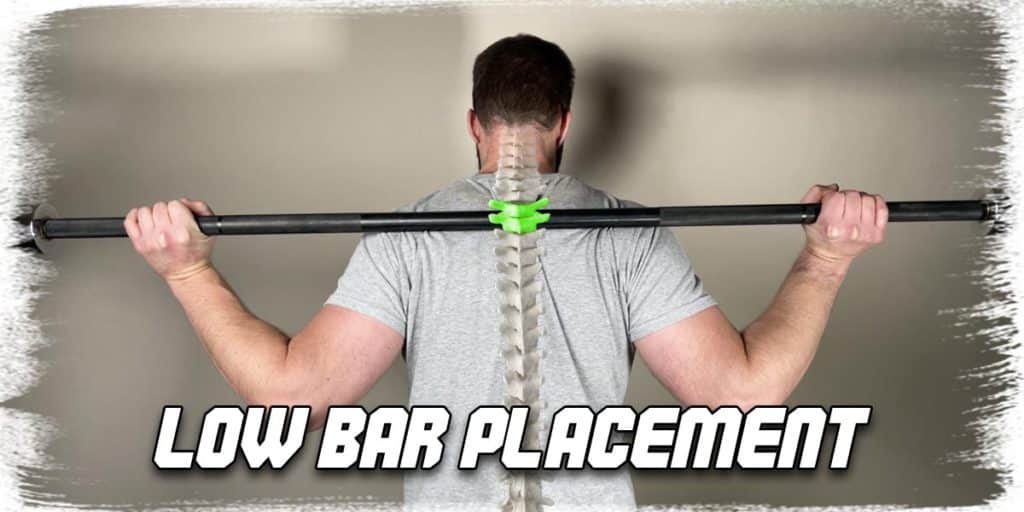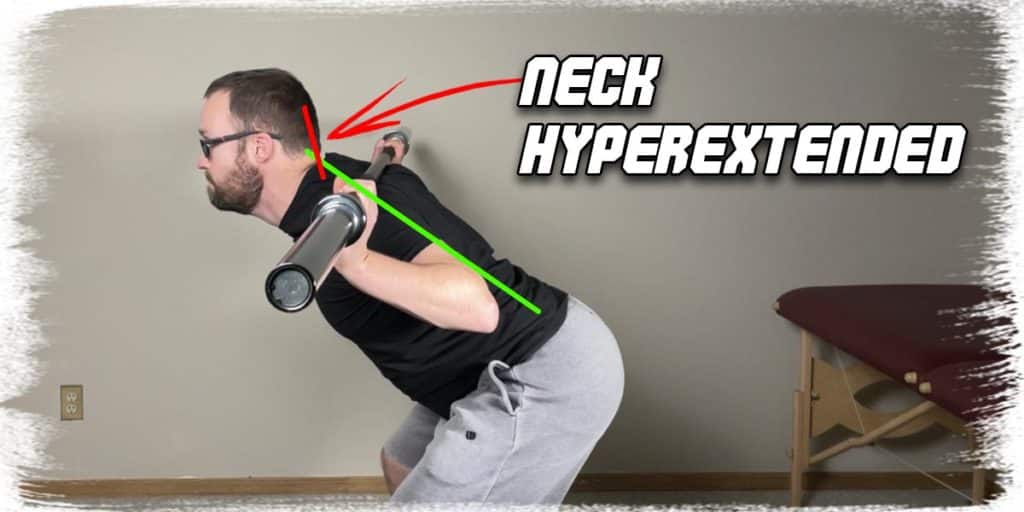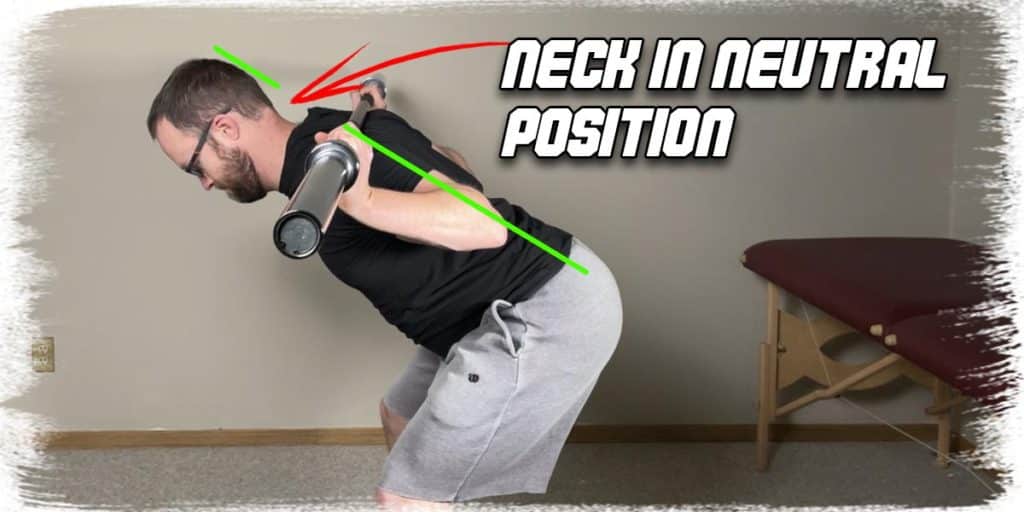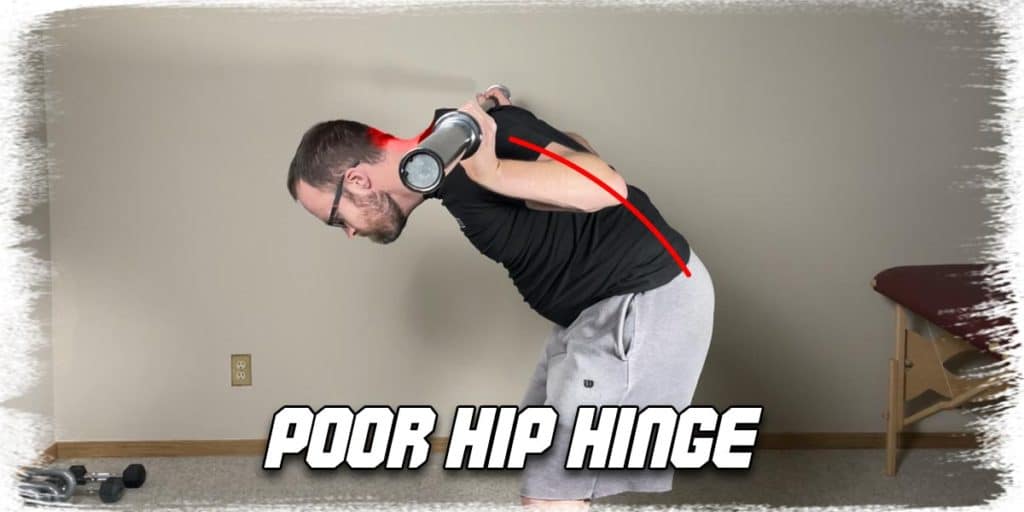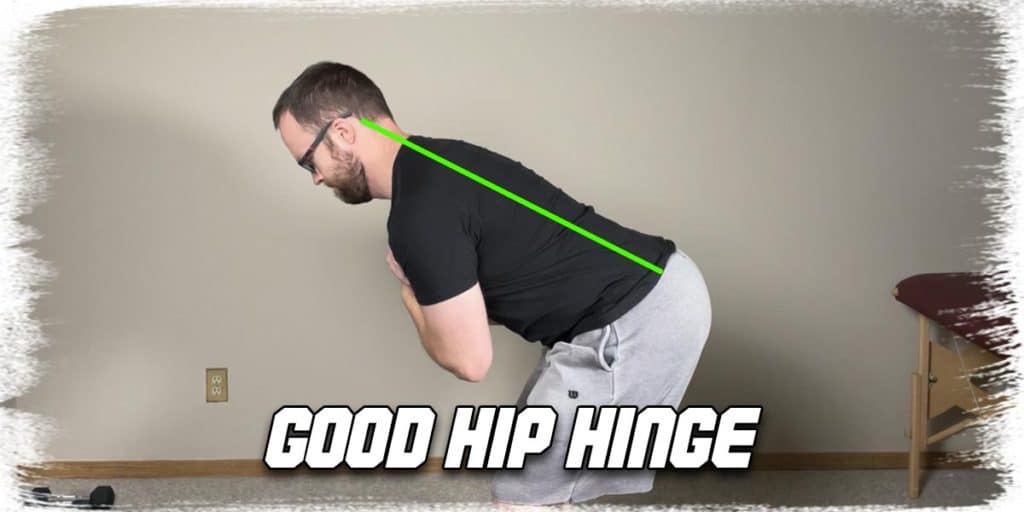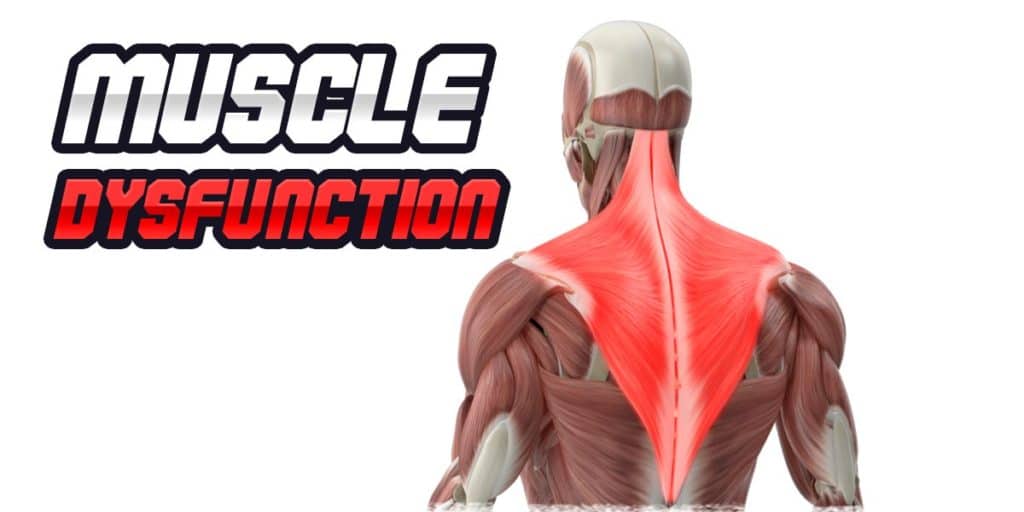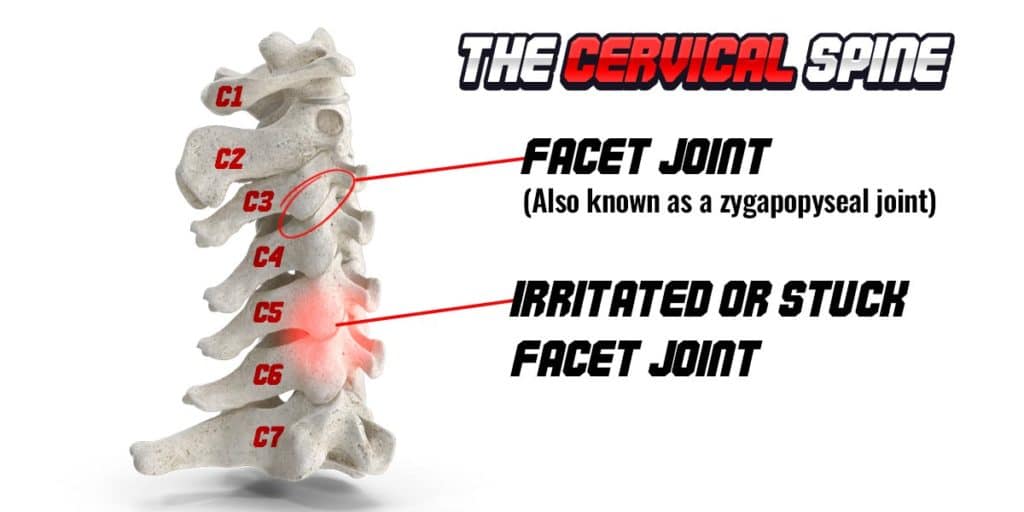Building a strong backside is a smart move to make. And when it comes to doing so, the good morning is a staple exercise that can help build a bulletproof backside. But there’s no point in performing this exercise if it repeatedly comes at the expense of experiencing neck pain. Thankfully, this article will walk you through all you need to know about why neck pain can occur during or after your good mornings and how to make sure it never happens again.
Neck pain from good mornings is most often the result of improper bar placement, improper head positioning during the exercise, poor hip hinge mechanics or upper back issues. Solutions involve using perfect bar placement, movement mechanics and improving upper back and shoulder mobility.
Of course, there’s a bit more to it than what’s briefly mentioned above, so if you want all the details, keep on reading!
Thankfully, if there’s one thing with this movement that my years of being a personal trainer and orthopedic physical therapist have taught me, it’s that these issues can often be cleaned up quite easily.
ARTICLE OVERVIEW
Click/tap on any of the headlines below to jump to that section of the article!
Issue 1: Improper bar placement
Issue 2: Improper head positioning
Issue 3: Poor hip hinging mechanics
Issue 4: Upper back issues
Related article: The Iron Neck: The ULTIMATE Review from a Physical Therapist
If you’re not sure what is likely to be causing your neck pain, take your time going through each of the issues outlined within this article, as it will serve as a systematic way to walk through where and why your pain might be arising when it comes to performing good mornings.
Of course, it’s always a smart idea to have a qualified healthcare professional help you out when it comes to figuring out why you’re experiencing neck pain, so make every effort to do so if your pain is becoming quite chronic, troublesome or intense in nature. But if that’s not in the cards for you, make sure you take some time to test out each of the steps in this article, which will hopefully help you narrow in on the underlying cause of the issue.
Issue 1: Improper bar placement
The first place to start when dissecting the potential reasons why you might be experiencing neck pain is to consider your bar placement. This is a common mistake that is most often seen in those newer to the strength training scene, specifically when it comes to using free weights.
Proper barbell placement can be a challenge for newer lifters. Unlike exercises that can be modified to avoid placing a barbell across the back (such as performing goblet squats instead of barbell back squats), the good morning requires a barbell to be placed on the back without any workarounds.
The barbell itself should never rest on your neck. Rather, it should be resting on your upper back. Generally speaking, resting the barbell around the level of your second or third vertebra will offer the greatest amount of comfort. Not only will this offload any unnecessary strain onto your neck muscles and joints, but this level of your upper back naturally has a decent amount of musculature, which will act as padding to disperse the pressure of the barbell resting on you.
The solution
If you haven’t been placing the barbell in the ideal spot across your upper back or find that it feels unnatural or uncomfortable to place it there, take some time to get familiar with this.
It’s often very helpful to grab a dowel, a broom handle, etc., and practice the good morning while holding the dowel across the upper back. As time goes on, you’ll become confident and familiar with finding the correct resting spot on your back. In terms of the ideal placement across your back, there’s ultimately two positions that you can try:
High bar placement
High bar placement involves placing the barbell just below the bottom (7th) cervical vertebra. If you bend your neck forwards and feel for the large bump at the base of your neck, that’s your 7th cervical vertebra. Try placing the barbell directly beneath this location (the first or second thoracic vertebra). It tends to be the more common position for barbell placement with the good morning exercise.
Low bar placement
Low bar placement tends to place the bar one or two vertebral levels lower than traditional high bar placement, usually around the second or third thoracic vertebra level. Many lifters opt to use low bar placement rather than high bar placement, and either is perfectly fine. Just be aware that the low bar position can require a bit more shoulder and chest mobility than the high bar placement, making it uncomfortable for some lifters with shoulder issues or tight pectoral muscles.
Pro tip: If you find the barbell to be uncomfortable while resting on your back, you can wrap a towel around it to help increase the padding and overall comfort. Most lifters quickly adapt to finding the barbell to be comfortable across their upper back.
Issue 2: Improper head positioning
If your barbell placement is on point, yet you still experience discomfort in your neck, the next likely candidate might be the position you hold your head and neck in when performing the exercise itself.
Many individuals opt to keep their eyes looking forward throughout the entire movement. While there is nothing wrong with this approach, some necks may not be tolerant to this as it may cause hyperextension of certain joints within the neck. If your neck is already stiff due to lousy joint mobility, trying to force it to maintain large ranges of extension-based motion in a neck that is not tolerant to these positions can be a recipe for neck pain.
If your chin pokes upwards at any point throughout the movement, you are moving your neck joints into extension or hyperextension, which is a common cause of neck discomfort.
If you perform your good mornings while looking straight ahead the entire time, consider trying a slightly different tactic: try performing the movement while keeping your neck in a more neutral position. This means that your eyes won’t stay looking straight ahead at all times. Instead, as you begin to bend/hinge forwards, focus on your neck remaining motionless (i.e. staying perfectly straight) and letting your vision/eyes go wherever needed as they come along for the ride.
Your eyes should likely still be able to look a bit forward at the end range, but just make sure that you don’t lose your balance, as you may initially find it a bit difficult to not be looking straight ahead at the bottom of the movement (if this is what you’re used to).
The solution
While in the standing position, make sure that your neck is straight with your chin slightly tucked in. Keep it in this position as you begin to initiate the movement. You’ll notice that you likely can’t keep your eyes looking straight ahead — and that’s ok.
As long as you still feel stable, let your eyes move as needed while keeping your neck straight. There should be very minimal or even zero movement coming from your neck if done correctly.
If you perform the movement as above and your neck pain does not arise, the pain generator likely is one of the facet joints within your neck. (Irritated joints won’t produce much/any pain if they’re not moved.)
Issue 3: Poor hip hinging mechanics
If your hip-hinging mechanics aren’t on point, it can cause a lot more pain than just your neck. So, as we talk about how poor hip hinging can be a cause of neck pain, keep in mind that you want to master this movement to ensure the health of your entire spine and back muscles in addition to your neck.
When dealing with neck pain, poor hip hinging mechanics with the good morning can cause hyperflexion or force you to produce massive amounts of extension, either of which can create abnormal stress and strain throughout the neck.
Generally speaking, if you lack the ability to hinge properly at the hips, you’ll likely produce flexion (rounding) through your entire spine rather than keeping it in a neutral-to-extended position. If you round your spine, your neck will likely follow. This can create an issue all by itself.
But, it may also lead you to excessively extend your neck in an attempt to not feel like you’re tipping your head upside down. This is not dissimilar to what was mentioned in the previous section regarding improper head positioning but is likely instead a more extreme version in terms of the force you’ll be ramming through your neck in attempts to look upright.
The solution
Take some time to ensure that your hip-hinging mechanics are on point. There are numerous hinging drills that you can find on the internet to help you learn to produce this movement correctly.
It may also be helpful to use your phone to video yourself performing the movement and then watch the footage to evaluate and critique your hinging abilities.
Remember: the hinge is the foundation of the good morning exercise, along with numerous other exercises as well. So, taking the time to perfect your hinging will help ensure pain-free lifting for not just the good morning but for all of your other exercises that require hinging to take place as well.
Issue 4: Upper back issues
You may not be aware of it, but issues such as joint stiffness and tight muscles in your upper back (the thoracic spine region) can be the culprit for pain or discomfort that you feel in your neck. So, it’s entirely possible that the issue you feel in your neck is actually the result of an issue arising in your upper back.
Anatomically speaking, your upper back and your neck are separate regions of the body, but functionally speaking, they are highly intertwined. In terms of the spine, from a functional perspective, the upper two thoracic vertebrae are considered part of the neck since these two bones still produce movement with general neck movements.1
Dysfunction is rather common in the upper back/neck region in just about everyone and not explicitly confined to lifters or active individuals. So, knowing that, it’s important to determine whether the issue I coming from the joints of the spine, the muscles, or both.
Tight muscles
When examining the muscles of the upper back, there are multiple muscles that span the upper spine and into the neck. These can include:
There are others, of course; however, these ones tend to be the more prominent trouble makers when it comes to muscles that have attachment points along the upper thoracic region and the cervical spine itself.
Related article: Six Benefits of Using an Acupressure Mat for Your Aches and Pains
In terms of how these muscles often work together to produce neck and upper back movements, it’s pretty common to have more than just a single muscle involved with pain, stiffness or generalized discomfort. Some of this might be coming from your actual training pursuits, but it’s highly likely that more of it is the result of your daily postures, abnormal movement patterns or some blend of all three.
The solution
Start by examining your standing and seated posture, or have someone evaluate it for you. “Ideal” posture is somewhat arbitrary, but taking a quick analysis of your natural posture can still reveal quite a bit of important information.2 If you’re someone who spends most of your days seated or stationary, you’ll likely have some form of postural dysfunction, such as upper crossed syndrome, which can rear its ugly head when it comes to performing various exercises and movements.
If your upper back muscles are tight, consider putting accessory exercises into your training regimen, such as face pulls, trap 3 raises, and power raises. Chronically tight muscles often lack adequate strength.3 It may sound counterintuitive, but when you strengthen muscles that are weak and tight, you will experience less pain and better mobility.
If it’s in your budget, feel free to get soft tissue treatments for these muscles. Massages, IASTM and other such treatments can offer benefits as well, but just don’t neglect the strengthening component, as that’s likely your primary and permanent ticket out of this mess.
Stuck or stiff joints
Hypomobile joints (joints that don’t move enough) are pretty common in the upper thoracic spine — I see it all day long in the clinic. It can often manifest as either a sharp, rather focal pain slightly off the center of the spine or even a deep (but very strong) ache or discomfort in the region.
Related Article: The BEST Way to Stretch Your Stiff Upper Neck: A Physio Explains
The joints themselves (known as facet joints) can often times have a hard time either flexing (think bending the upper spine) or extending (think straightening the upper spine).
As an example: if your joints don’t want to extend, but you’re trying to keep your upper back as straight as possible during the hip hinging portion of the exercise, the joints will likely have a hard time sliding backwards, which can be felt as generalized stiffness, discomfort or even pain.
The solution
If you’re pretty sure that one or more of your facet joints aren’t moving as much as normal, it’s not a bad idea to have a qualified healthcare practitioner help you restore their mobility.
But if that’s not in the cards for you, or you want to start making some progress right away, consider performing exercises that target the rotational, side-bending, flexing and extending movements of your upper spine. Put them into your regular training regimen for the next couple of months and you’ll likely experience some profound changes.
You can Google the following exercises if you’re not sure what they are and wish to give them a go!
Some of my favorite exercises for improving rotation of the upper thoracic joints include:
- Open books
- The Alexander shoulder roll
- Quadruped thoracic spine rotations
Some of my favorite exercises for improving flexion & extension of the upper thoracic joints include:
- Cat/cows
- Foam rolling with a flexion bias of the thoracic spine
- Foam rolling with an extension bias of the thoracic spine
Final thoughts
The good morning is a classic exercise that is brilliant at lighting up and strengthening your backside, but it should never cause neck pain. If you’re finding that your neck is constantly complaining either during or after performing this movement, take the time to work through the steps required to get the underlying issue figured out and under control.
Doing so will prolong your training longevity, make your training more enjoyable and a lot more effective since you won’t be limited by any nagging or annoying pain in your neck. Train hard, train smart and make the effort to always respect what your body is telling you throughout the training process.
References:

Hi! I’m Jim Wittstrom, PT, DPT, CSCS, Pn1.
I am a physical therapist who is passionate about all things pertaining to strength & conditioning, human movement, injury prevention and rehabilitation. I created StrengthResurgence.com in order to help others become stronger and healthier. I also love helping aspiring students and therapists fulfill their dreams of becoming successful in school and within their clinical PT practice. Thanks for checking out my site!

